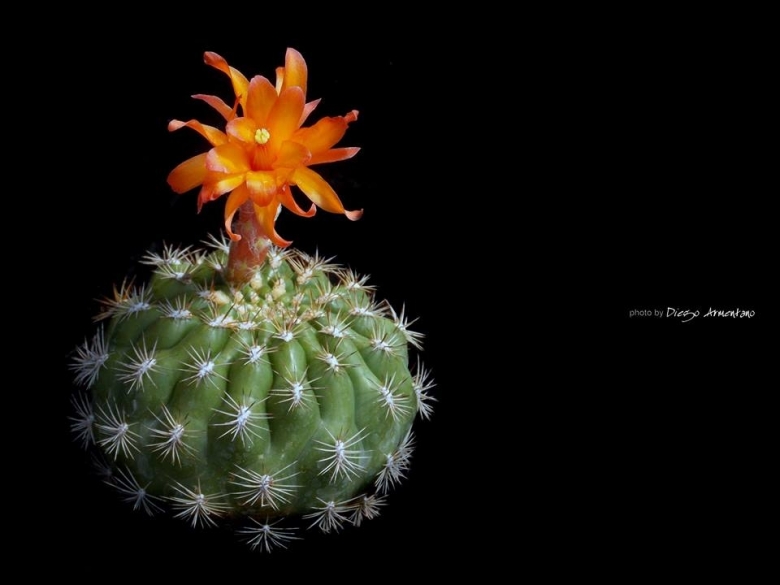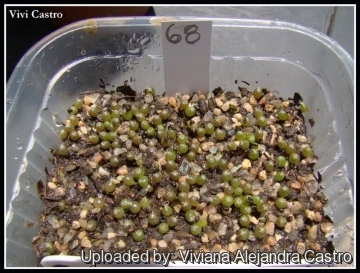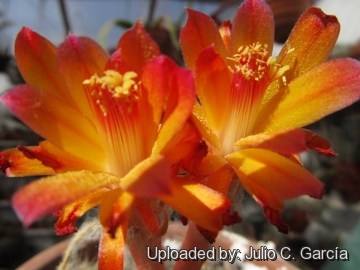




Your support is critical to our success.

Origin and Habitat: Matucana intertextaSN|6019]]SN|6019]] is endemic to Peru. It is only found in the Cajamarca region (extent of occurrence is 800 km2)
Altitude range: 2,000 to 2,600 metres above sea level.
Habitat and Ecology: This solitary species occurs in inter-Andean valleys. Illegal collection and trade represents a threat, but it is also cultivated to be used as an ornamental plant.
Synonyms:
- Matucana intertexta F.Ritter
- Borzicactus intertextus (F.Ritter) Donald
- Submatucana intertexta (F.Ritter) Backeb.
Description: Matucana inertexta is a low-growing, globular cactus from Peru. This plant is a possible relative of Matucana aurantiaca but differing in having 15-25 crenate ribs, 1-4 brown tipped central spines and golden yellow flowers tipped in red.
Habit: Plants usually solitary or (rarely) forming just a few offsets around the base.
Stem: Depressed to somewhat cylindrical (particularly in cultivation), green up to 18 cm broad, about 20 cm tall rarely up to 30 cm.
Ribs: 15-25, crenate.
Central spines: 1-4, brown, dark-tipped, 2-3.5 cm long.
Radial spines: 8-12, intertwined 8-20 mm long. Morphological form with finer and darker spines are also reported.
Flowers: Somewhat radially symmetrical (not zigomorphyc) slender up to 7 cm long, 3 cm wide. Perianth segments golden yellow to pale-orange (occasionally pink), apices blood red or violet.
Blooming season: Spring to early summer.
Remarks: Matucana inertexta along with the related Matucana formosaSN|6089]]SN|5976]], Matucana weberbaueriSN|5976]]SN|6089]], Matucana huagalensis and Matucana ritteri is part of the Matucana aurantiaca group.
Subspecies, varieties, forms and cultivars of plants belonging to the Matucana aurantiaca group
Matucana aurantiaca is variable and many populations have been given separate species names which in the complex forms a group comprising Matucana aurantiaca, Matucana ritteri, Matucana formosa, Matucana inertexta, Matucana huagalensis and Matucana weberbaueri.
- Matucana aurantiaca (Vaupel) F.Ritter: (subsp. aurantiaca) has about 16 somewhat spiralled and tuberculate ribs. Spines 20-25. Flowers orange-red. Distribution: Northern Peru.
 Matucana aurantiaca subs. currundayensis (F.Ritter) Mottram: Distribution: Cerro Currunday (Otuzco, Samne and adjacent areas), La Libertad department, Peru.
Matucana aurantiaca subs. currundayensis (F.Ritter) Mottram: Distribution: Cerro Currunday (Otuzco, Samne and adjacent areas), La Libertad department, Peru.- Matucana aurantiaca subs. fruticosa (F.Ritter) Mottram
- Matucana aurantiaca subs. hastifera (F.Ritter) Mottram
 Matucana aurantiaca subs. polzii (Diers, Donald & Zecher) Mottram
Matucana aurantiaca subs. polzii (Diers, Donald & Zecher) Mottram- Matucana calvescens (Kimnach & Hutchison) Buxb.
- Matucana formosa F.Ritter: has 20-30 weackly tuberculate ribs, Spines dark brown tipped black. Flowers crimson. Distribution: valley of the Maranon, Cajamarca and Amazonas, Peru.
- Matucana huagalensis (Donald & A.B.Lau) Bregman, Meerst., Melis & A.B.Pullen: very similar to Matucana intertexta but darker coloured. Flowers white or pale pink. Distribution: Maranon
and Rio Crisnejas, Cajamarca, Peru.  Matucana intertexta F.Ritter: has 15-25 crenate ribs, Spines dark brown tipped black. Flowers golden yellow with blood red apices. Distribution: Cajamarca, Peru.
Matucana intertexta F.Ritter: has 15-25 crenate ribs, Spines dark brown tipped black. Flowers golden yellow with blood red apices. Distribution: Cajamarca, Peru. Matucana pallarensis F.Ritter: Distribution: El Chagual, La Libertad department, Peru.
Matucana pallarensis F.Ritter: Distribution: El Chagual, La Libertad department, Peru. Matucana ritteri Buining: has fewer spines (8-15) and 12-22 ribs. Flowers, oblique, relatively narrow-tubed, vermilion-carmine with violet petals edge. Distribution: Otuzco, Department of La Libertad, Peru
Matucana ritteri Buining: has fewer spines (8-15) and 12-22 ribs. Flowers, oblique, relatively narrow-tubed, vermilion-carmine with violet petals edge. Distribution: Otuzco, Department of La Libertad, Peru Matucana weberbaueri (Vaupel) Backeb.: has more numerous (25-40) golden yellow or brownish spines and yellow or arange flowers. Distribution: Balsas to Chachapoyas, west side of the Rio Maranon in the department of Amazonas in Peru.
Matucana weberbaueri (Vaupel) Backeb.: has more numerous (25-40) golden yellow or brownish spines and yellow or arange flowers. Distribution: Balsas to Chachapoyas, west side of the Rio Maranon in the department of Amazonas in Peru. Matucana weberbaueri var. flammea (Donald) Slaba: has orange-red flowers instead of yellow. Distribution: Balsas above the Canyon Maronan in the province of Chachapoyas, department of Amazonas in Peru.
Matucana weberbaueri var. flammea (Donald) Slaba: has orange-red flowers instead of yellow. Distribution: Balsas above the Canyon Maronan in the province of Chachapoyas, department of Amazonas in Peru.
Bibliography: Major references nad further lectures
1) James Cullen, Sabina G. Knees, H. Suzanne Cubey "The European Garden Flora Flowering Plants: A Manual for the Identification of Plants Cultivated in Europe, Both Out-of-Doors and Under Glass" Cambridge University Press, 11/Aug/2011
2) David R Hunt; Nigel P Taylor; Graham Charles; International Cactaceae Systematics Group. "The New Cactus Lexicon" dh books, 2006
3) Ostalaza, C. & Roque, J. 2013. Matucana intertexta. The IUCN Red List of Threatened Species. Version 2014.2. <www.iucnredlist.org>. Downloaded on 11 August 2014

Seedlings. Photo by: Viviana Alejandra Castro

Matucana intertexta Photo by: Julio C. García
Cultivation and Propagation: Matucana intertextaSN|6019]]SN|6019]] is a summer-growing species of relatively easy cultivation. This plant is adapted to dry soils and is quite susceptible to over-watering if kept in a non ventilated place.
Growth rate: Matucanas grow slowly in their natural habitats, but in greenhouses they grow more quickly.
Soil: Grow it in a rich, open, sandy-gritty cactus compost. It needs good drainage and a deep pot to accommodate its tap root.
Repotting: Repot in the spring when the roots become cramped. Generally, these plants should be re-potted every other year, in order to provide fresh soil. However, this doesn't necessarily mean they'll need larger containers. After repotting, do not water for a week or more.
Exposure: It is suited for sunny-brightly exposure, but can tolerate light shade. However it will do its best only with lots of sun and become stressed with inadequate light which could result in poor growth and unnatural shape. Direct sun is also beneficial in order to get a good spine colouration.
Watering: Water sparingly and keep it completely dry during winter. Mature individuals easily rot and die especially after transplanting so be extremely cautious with watering. Keep dry in winter or when night temperatures remain below 10° C. Water it less than average if in bigger pots.
Fertilization: Feed them once during the growing season with a fertilizer specifically formulated for cactus and succulents (high potash fertilizer with a dilute low nitrogen), including all micro nutrients and trace elements diluted to ½ the strength recommended on the label. They thrive in poor soils and need a limited supplies of fertilizer to avoid the plants developing excess vegetation, which is easily attacked by fungal diseases.
Special need: It is suited for airy exposures. Provide very good ventilation. Nearly all problems occur as a result of overwatering and poor ventilation, especially when weather conditions are dull and cool or very humid. They must have very dry atmosphere.
Hardiness: It likes warmth (recommended minimum winter temperature 5° C) But plants kept perfectly dry but may to survive a light frost.
Pests & diseases: These cacti may be attractive to a variety of insects, but plants in good condition should be nearly pest-free, particularly if they are grown in a mineral potting-mix, with good exposure and ventilation. Nonetheless, there are several pests to watch for:
- Red spiders: Red spiders may be effectively rubbed up by misting the plants from above.
- Mealy bugs: Mealy bugs occasionally develop aerial into the new leaves and flowers with disfiguring results, but the worst types develop underground on the roots and are invisible except by their effects.
- Scales, thrips and aphids: These insects are rarely a problem.
- Rot: Rot is only a minor problem if the plants are watered and “aired” correctly. If they are not, fungicides won't help all that much.
Propagation: Usually propagated from seeds (seldom produces offsets). The seeds can be sown in pots of fine, well-drained sandy soil, any time during the spring when temperatures are warm. Cover the seeds with a fine layer of grit and water from below with a fungicide to prevent damping off. For the 1-2 weeks cover the pots with a sheet of glass/clear perspex to keep the humidity levels high. Remove the glass and replace it with light shade-cloth and mist once or twice a day for the next two weeks after which most seeds should have germinated. From then on mistings can be reduced to every second and then every third day as the little plants grow. The seedlings should not be disturbed until they are well rooted after which they can be planted separately in small pots.
| Your Actions | |
|---|---|
| Back to Matucana index | |
| Back to Cactaceae index | |
 |
Back to Cacti Encyclopedia index |
Privacy stantement - Terms and conditions - How to cite - About us - Feedback - Donate



